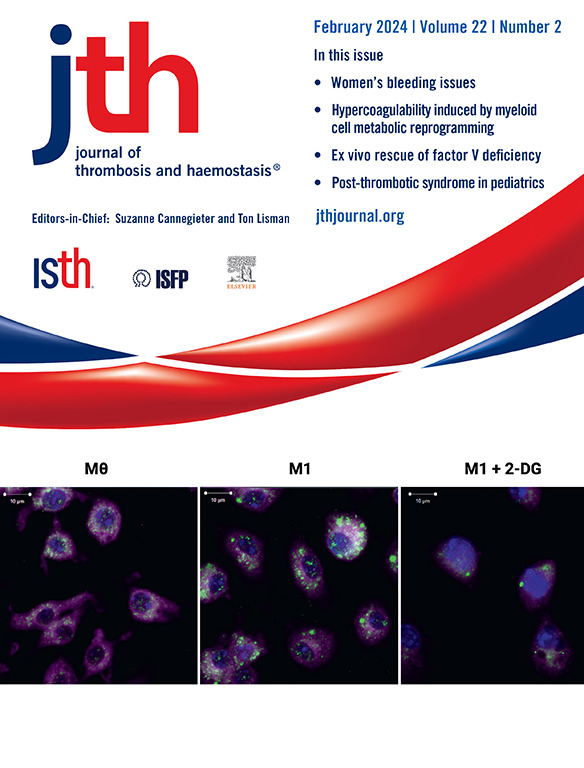米尔维昔安单独或联合肝素对导管诱导凝血和凝血酶生成的影响。
IF 5
2区 医学
Q1 HEMATOLOGY
引用次数: 0
摘要
背景:口服因子(F) XIa抑制剂Milvexian正在进行急性冠脉综合征的3期评估。此类患者通常需要经皮冠状动脉介入治疗(PCI)。PCI导管通过诱导FXII和FXI激活触发凝血。目前尚不清楚milvexian是否阻断了这一作用,或者是否需要辅助肝素。目的:(a)比较FXII-或xi -消耗对导管凝血的影响,(b)研究导管诱导的FXI激活,(c)确定米尔维昔安单独或与肝素联合使用对导管诱导的凝血和凝血酶生成的影响。方法:在96孔板实验中,分别通过监测吸光度和凝血酶底物水解来评估钙化对照血浆和凝血酶生成。通过显色法评估导管、FXII或凝血酶对FXI的激活。在对照血浆中加入米尔维昔安、达比加群、肝素或米尔维昔安加肝素来评估效果。结果:导管促进FXI的自身激活,增强FXII和凝血酶介导的FXI激活。在fxii缺失的血浆中凝血功能减弱,在fxii缺失的血浆中凝血功能消失。即使是少量的FXI也会引发凝血。临床相关浓度的米尔维昔安和达比加群不能阻止导管诱导的凝血或凝血酶的产生。肝素增强了米勒维森对导管诱导凝血的抑制作用。结论:导管可促进FXI的自动激活,绕过FXI,突出FXI的关键作用。milvexian有限的容量支持了在接受PCI治疗的milvexian患者需要辅助肝素。本文章由计算机程序翻译,如有差异,请以英文原文为准。
Effects of milvexian alone or with heparin on catheter-induced clotting and thrombin generation
Background
Milvexian, an oral factor (F)XIa inhibitor, is undergoing phase 3 evaluation for acute coronary syndrome. Such patients often require percutaneous coronary intervention (PCI). The PCI catheters trigger clotting by inducing activation of FXII and FXI. It is unknown whether milvexian blocks this or if adjunctive heparin is needed.
Objectives
To (a) compare the effect of FXII depletion or FXI depletion on catheter clotting, (b) investigate catheter-induced FXI activation, and (c) determine the effect of milvexian alone or with heparin on catheter-induced clotting and thrombin generation.
Methods
In a 96-well plate assay, catheter-induced clotting and thrombin generation were assessed in recalcified control or depleted plasmas supplemented with control plasma by monitoring absorbance and thrombin substrate hydrolysis, respectively. FXI activation by catheters, FXIIa, or thrombin was evaluated by chromogenic assay. Milvexian, dabigatran, heparin, or milvexian plus heparin were added to control plasma to assess effects.
Results
Catheters promoted autoactivation of FXI and augmented FXIIa- and thrombin-mediated FXI activation. Clotting was attenuated in FXII-depleted plasma and abolished in FXI-depleted plasma. Even small amounts of FXI triggered clotting. Milvexian and dabigatran at clinically relevant concentrations did not prevent catheter-induced clotting or thrombin generation. Heparin potentiated milvexian’s inhibitory effect on catheter-induced clotting.
Conclusion
Catheters promote FXI autoactivation, bypassing FXII, and highlighting the critical role of FXI. The limited capacity of milvexian supports the need for adjunctive heparin in patients treated with milvexian undergoing PCI.
求助全文
通过发布文献求助,成功后即可免费获取论文全文。
去求助
来源期刊
CiteScore
24.30
自引率
3.80%
发文量
321
审稿时长
1 months
期刊介绍:
The Journal of Thrombosis and Haemostasis (JTH) serves as the official journal of the International Society on Thrombosis and Haemostasis. It is dedicated to advancing science related to thrombosis, bleeding disorders, and vascular biology through the dissemination and exchange of information and ideas within the global research community.
Types of Publications:
The journal publishes a variety of content, including:
Original research reports
State-of-the-art reviews
Brief reports
Case reports
Invited commentaries on publications in the Journal
Forum articles
Correspondence
Announcements
Scope of Contributions:
Editors invite contributions from both fundamental and clinical domains. These include:
Basic manuscripts on blood coagulation and fibrinolysis
Studies on proteins and reactions related to thrombosis and haemostasis
Research on blood platelets and their interactions with other biological systems, such as the vessel wall, blood cells, and invading organisms
Clinical manuscripts covering various topics including venous thrombosis, arterial disease, hemophilia, bleeding disorders, and platelet diseases
Clinical manuscripts may encompass etiology, diagnostics, prognosis, prevention, and treatment strategies.

 求助内容:
求助内容: 应助结果提醒方式:
应助结果提醒方式:


